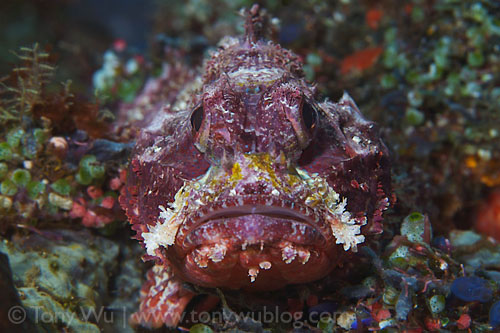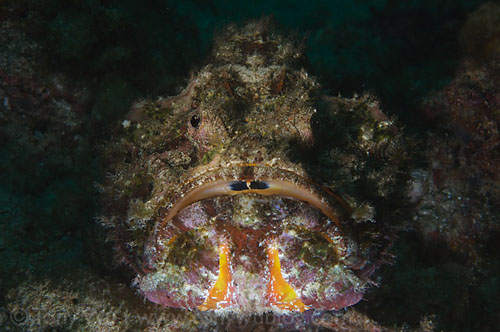One of my favourite perspectives for fish portraits is head-on, full-face.
If you find yourself with a cooperative (i.e., stationary) subject and want to try a face-on shot, it may help to keep a few things in mind.
First, make sure you pay attention to symmetry. One way to do this is to keep your eyes on the fish's eyes. Ideally, the fish should be looking at you, not away or to the side...and both eyes should be equidistant from the center of the frame. Lining up the dorsal fin/ long axis of the fish along the center of the frame often helps.
Once you've lined everything up, double check framing. Just like when you're crossing the street...look left, then look right, then look left again. Make sure the position of the fish is balanced in the frame, and keep an eye out for extraneous visual distractions. Usually, you'll want to keep the composition as simple and clutter-free as possible, but there are exceptions of course.
For instance, this scorpionfish in Ambon just happened to be sitting among a pretty patch of tunicates and other stuff, which although visually chaotic, ended up making for a nice pattern around the fish.

I don't generally think of scorpionfish as cute, but this one nearly qualifies.
Another thing you'll want to consider is lighting (yes, I'm babbling on about lighting again).
The photo below is of a particularly grotesque scorpionfish. It was large, ugly and mean-looking. More importantly, it was puke-patterned...meaning "having a hue and texture reminiscent of stale vomit". The rocks around it weren't any prettier, so all-in-all, it was a fairly hopeless scenario...photographically at least.
Being a sucker for lost causes, I sat with my aesthetically challenged acquaintance for a while, contemplating what, if anything, to do. After several minutes, I decided to try to emphasise the fish's inherent charms and go for a spooky, haunted-house kind of effect.

The lighting here is one light from below, one light from above at reduced power and at a sharp angle. The effect is to frame only the fish with light. Hitting the scene with more light would've brought out the ugly rocks around the fish...something I didn't want to do.
Incidentally, I took this photo during the day...not at night. Closing the aperture down to f14 at ISO100 and using a shutter speed of 1/200 was sufficient to darken the scene down so that I had complete control over all the light in the image.
The fish's puffed-up look was a bit of luck. It's a threat gesture, probably intended to make itself look bigger and badder than it already did...the fish's way of telling me: "I don't like having my picture taken."
I'm sure the fish would've felt differently if it could've seen how flattering the result turned out.